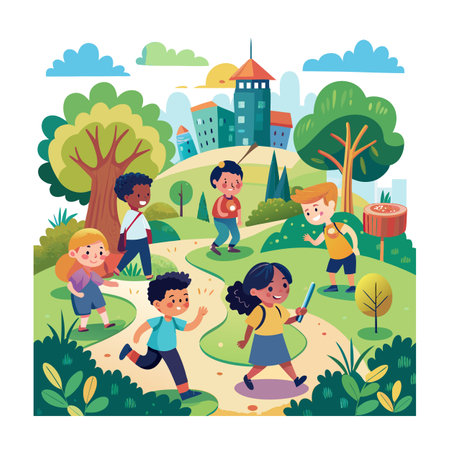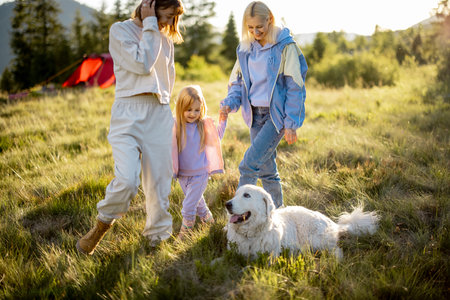Introduction: The Heart of British Farmland
Amid rolling hills and patchwork fields, the British countryside tells a story as old as time—a living tapestry woven with the golden threads of tradition, nature, and rural life. Farmland in the UK is more than a landscape; it is the beating heart of local communities, a cradle for age-old customs, and a sanctuary for native wildlife. Here, ancient hedgerows mark boundaries that have stood for generations, while the gentle rhythm of farm life shapes the pace of rural existence. Each season brings its own spectacle: lambs frolic in spring meadows, summer hayfields sway under wide-open skies, and autumn mists settle over rows of ripening crops. This land is treasured not only for its productivity but also for its beauty and the sense of belonging it offers. As newcomers and children discover these green spaces, there lies both an opportunity and a responsibility—to learn how to tread gently, respect traditions, and keep themselves and others safe amidst this enchanting yet working environment.
2. Understanding Country Codes: The Essentials for All Ages
The rolling fields and bridleways of the British countryside are steeped in tradition, but they are also shared spaces that require respect, care, and a sense of community. For both children growing up amidst these green pastures and newcomers experiencing rural life for the first time, understanding the Countryside Code is essential. This code is more than a set of guidelines; it is the heartbeat of harmonious living among people, animals, and nature.
The Countryside Code outlines how to enjoy rural landscapes responsibly, ensuring safety for everyone who treads its paths and works its land. By embracing these principles from an early age or upon arrival in the UK, individuals cultivate habits rooted in respect and responsibility. These values ripple outwards—protecting wildlife, supporting local farmers, and maintaining peace between visitors and residents.
The Pillars of the Countryside Code
| Principle | Description |
|---|---|
| Respect Everyone | Be considerate to those living, working, and enjoying the countryside. Leave gates as you find them and follow local signage. |
| Protect the Environment | Avoid damaging crops or disturbing livestock. Take litter home and keep dogs under control at all times. |
| Enjoy Responsibly | Plan ahead and be prepared—wear suitable clothing, bring maps, and know your route to ensure your own safety and that of others. |
Nurturing Respect in Young Minds and Newcomers
For children, learning these codes becomes a natural extension of their outdoor play—turning daily walks into lessons about kindness to creatures great and small, or about why it’s important not to trample wildflowers. For newcomers, these codes serve as an introduction to British rural customs, helping them build connections with their new communities through shared understanding and mutual care.
Cultivating Lifelong Habits for a Thriving Countryside
By weaving the Countryside Code into education—whether at school or through community workshops—we plant seeds of stewardship that grow strong across generations. In doing so, we ensure that every footstep on farmland is guided by curiosity tempered with caution, adventure balanced by awareness. The countryside becomes not just a place to visit, but a living story we all help write with every respectful action.

3. Storytelling and Exploration: Making Safety Memorable
Across the rolling hills and patchwork fields of the British countryside, stories have long served as a gentle bridge between generations. When teaching children and newcomers about safe and respectful behaviour on UK farmland, weaving local tales and personal anecdotes into lessons transforms rules into lived experiences. Imagine gathering beneath an ancient oak, its branches whispering with the memory of old farmhands, and sharing stories of how a careless footstep once startled grazing sheep, or how a forgotten gate led to an adventurous pony’s escape. Such narratives do more than instruct—they ignite curiosity and foster a deep sense of connection with the land.
By recounting these moments—some humorous, others cautionary—we invite newcomers to see themselves as part of a living story. Children listen wide-eyed to their elders describing the changing seasons, the silent watchfulness needed when walking near nesting birds, or the importance of leaving wildflowers untouched for bees and butterflies. These tales plant seeds of reverence and responsibility, reminding everyone that every field has its own rhythm and every hedge shelters secrets worth respecting.
Encouraging exploration under careful guidance further strengthens these lessons. A stroll through a dewy meadow at dawn or helping gather eggs from a henhouse can be powerful opportunities for hands-on learning. In these moments, practical safety guidelines—like closing gates behind you or sticking to marked paths—are not abstract rules but shared wisdom, passed down like cherished family lore. This blend of storytelling and experiential learning ensures that respect for the countryside isn’t simply taught; it’s felt deeply within the heart, lasting long after muddy boots are set aside by the door.
Farmyard Friendships: Meeting Animals with Care
There is a special kind of magic in meeting animals on a British farm—the gentle flick of a lamb’s ear, the curious gaze of a cow, or the soft clucking of hens. For children and newcomers to the countryside, these encounters can be moments of wonder and learning. However, such moments also require respect, patience, and understanding for both animal welfare and personal safety.
Understanding Animal Behaviour
Each animal on the farm has its own temperament. Sheep may startle easily, cows are inquisitive but cautious, and pigs can be surprisingly clever. Observing an animal’s body language—such as raised ears, swishing tails, or shifting weight—offers clues about their comfort. Remind young ones and visitors that slow movements, quiet voices, and stillness help animals feel safe and respected.
Approaching Farm Animals: A Handy Guide
| Animal | How to Approach | Signs of Distress | Respectful Actions |
|---|---|---|---|
| Cows | Approach from the side, not head-on; speak softly | Tails swishing fast, backing away, loud mooing | Stand calmly; avoid sudden movements; never chase |
| Sheep & Lambs | Let them come to you; sit quietly nearby if possible | Bunching together, running away, bleating loudly | Keep distance; never pick up lambs; watch quietly |
| Pigs | Wait at the gate; let them sniff your hand if they wish | Loud grunts, baring teeth, retreating quickly | Offer gentle greetings; do not feed by hand without permission |
| Chickens & Ducks | Move slowly; crouch down to their level if possible | Puffing up feathers, alarm calls, rapid movement away | Avoid chasing; do not touch unless invited by the farmer |
The Importance of Kindness and Mindfulness
In every encounter, kindness is key. Teach children to notice when an animal needs space and celebrate those peaceful moments spent simply watching from afar. Encourage questions about what animals eat or how they live. Remind everyone that farm animals are not pets—they are working creatures with their own routines and needs. Through careful observation and mindful actions, we build trust with our farmyard friends while protecting both their wellbeing and our own.
5. Nature’s Classroom: Hands-On Learning Activities
There is no better way to understand the gentle rhythm of British farmland than by stepping directly into nature’s classroom. For children and newcomers alike, immersive activities offer both education and joy—blending the wonders of rural life with the importance of safety and respect for the land.
Pond-Dipping: Discovering Waterlife
Equipped with nets and buckets, pond-dipping introduces young minds to Britain’s rich aquatic habitats. Under careful supervision, children can gently scoop up tadpoles or water beetles, learning to identify native species before returning them safely to their home. This mindful interaction fosters curiosity while reinforcing the need to leave no trace—honouring both life and landscape.
Sensory Walks and Wildflower Spotting
A slow wander along hedgerows or through meadows offers a tapestry of sights, sounds, and textures. Guided sensory walks encourage participants to notice the hum of bees in foxgloves or the earthy scent after rain. With every step, adults remind children to tread lightly—sticking to paths, respecting fences, and leaving wildflowers for pollinators and passersby alike.
Gentle Foraging: A Taste of the Countryside
Foraging invites a delicious connection with nature but must be approached responsibly. Under guidance, groups can gather blackberries or wild garlic, learning the golden rules: always positively identify plants, pick only what you need, and never disturb protected species or private land. Sharing a hedgerow snack becomes a lesson in gratitude and stewardship.
Practical Skills Workshops
Children delight in hands-on tasks such as building bug hotels from twigs or helping mend a stile. Newcomers might join a local farmer for lamb feeding or apple pressing—activities steeped in tradition that reveal the quiet teamwork sustaining rural communities. Each workshop weaves practical skills with a deep respect for countryside customs.
Safety First in Every Adventure
Throughout these experiences, clear guidance ensures that everyone understands how to stay safe—from avoiding livestock enclosures to washing hands after outdoor play. By weaving safety into every story and activity, we help newcomers and children grow in confidence—ready to cherish and protect the living tapestry of UK farmland.
6. Building a Tradition: Passing Down Knowledge and Stewardship
In the rolling patchwork of UK farmland, every hedgerow, stile, and ancient path holds stories shared across generations. It is here, amidst the gentle hum of bees and the whispering grass, that traditions of countryside stewardship are woven into daily life—quietly handed down from elders to children and newcomers alike. The countryside is not merely a backdrop for rural living; it is a living classroom where community role models play a vital part in shaping attitudes toward land, wildlife, and one another.
The Role of Local Champions
Grandparents, seasoned farmers, and long-settled villagers often become informal mentors within their communities. Their deep-rooted knowledge—gleaned from years observing the changing seasons and tending to flocks or crops—is invaluable. Through friendly guidance on everything from closing gates behind you to respecting nesting birds in spring, these local champions teach that every action has an impact. Their example sets a tone of respect that echoes far beyond the farm’s edge.
Stories That Bind Generations
British countryside culture thrives on storytelling. Children huddled around a kitchen table or walking through dew-soaked fields hear tales of harvest festivals, lost footpaths rediscovered, or hard-won lessons about livestock safety. These stories do more than entertain—they instil a sense of belonging and responsibility. Newcomers, too, are invited to listen and learn, gradually absorbing the unwritten rules that keep both people and nature safe.
Cultivating Lifelong Respect
When communities actively nurture this intergenerational sharing, they build a tradition stronger than any signpost or rulebook could offer. Respect for the land becomes second nature—a legacy carried forward by each new pair of muddy boots. Whether through village events, school visits to working farms, or neighbourly chats over garden fences, these moments of connection reinforce the idea that everyone shares in protecting the countryside’s beauty and bounty.
Ultimately, it is this quiet passing down of knowledge—rooted in kindness and care—that ensures the British countryside remains cherished for generations to come. By honouring those who came before us and welcoming those newly arrived, we forge communities where safe and respectful practices are as enduring as the hills themselves.


